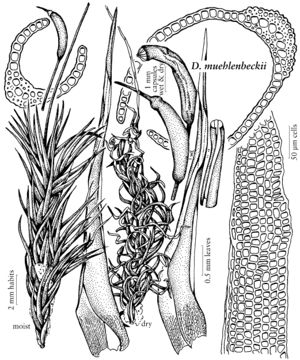Dicranum muehlenbeckii
Bryol. Europ. 1: 142, plate 78. 1847,.
Plants in dense tufts, green to yellowish green, dull. Stems 3–7 cm, densely tomentose with reddish-brown rhizoids. Leaves erect-spreading, strongly cirrate to crisped when dry, smooth, (4–) 5–6.5 (–8) × 0.5–1 mm, concave below, tubulose above, lanceolate, acute; margins entire below, slightly serrate to entire above; laminae 1-stratose; costa excurrent, 1/6–1/4 the width of the leaves at base, smooth or weakly toothed above on abaxial surface, abaxial ridges absent, with a row of guide cells, two stereid bands extending to the apex, adaxial and abaxial epidermal layers of cells differentiated; cell-walls between lamina cells slightly bulging; leaf cells smooth to slightly rough above on abaxial surface; alar cells 2-stratose, differentiated, sometimes extending to costa; proximal laminal cells rectangular, pitted, (19–) 37–55 (–73) × (5–) 9–12 (–14) µm; distal laminal cells short, irregularly quadrate-rectangular, not pitted, (7–) 11–12 (–23) × (6–) 8–9 (–13) µm. Sexual condition pseudomonoicous; dwarf males on stem rhizoids of female plants; interior perichaetial leaves abruptly short-acuminate, convolute-sheathing. Seta 1.3–3 cm, solitary, yellowish to yellowish-brown. Capsule 2–4 mm, long-cylindric, arcuate and inclined to ± straight and nearly erect, smooth, striate when dry, yellowish-brown; operculum 1.5–2.5 mm. Spores 14–24 µm.
Phenology: Capsules mature in summer.
Habitat: Humus and sandy soil on cliffs, bluffs, often over boulders and among rocks in open woods or exposed sites
Elevation: 10-3100 m
Distribution
Greenland, Alta., B.C., Man., N.B., Nfld. and Labr. (Nfld.), N.W.T., Nunavut, Ont., Que., Yukon, Alaska, Colo., Mass., Mont., Nebr., N.J., N.Mex., N.Y., N.Dak., S.Dak., Vt., Wyo., Europe, Asia
Discussion
Dicranum muehlenbeckii is a somewhat rare species throughout North America, where it is often misidentified as other species of the genus. There should be no reason for its misidentification if its important characters are utilized for recognition. Smooth, erect-spreading leaves, cirrate to crisped when dry and tubulose above, smooth leaf cells, 1-stratose laminae, and cross section of the costa showing the abaxial and adaxial rows of cells differentiated, all combine to make the gametophytes different from all other North American species of the genus. Sporophytes are rarely produced but the 2–4 mm, solitary, long-cylindric, slightly strumose capsules, which are suberect to slightly arcuate and weakly striate when dry, are distinctive.
Selected References
None.
